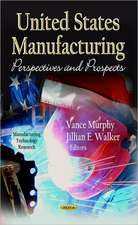Liquid-Liquid and Solid-Liquid Extractors
Autor Jean-Paul Duroudieren Limba Engleză Hardback – 6 sep 2016
The author also provides methods needed for the understanding the machinery used in applied thermodynamics in the hopes of encouraging students and engineers to construct the programs they need. Chapters are complemented with appendices which provide additional information and associated references.
- Presents reliable and simple methods of extraction and partitioning
- Provides a clear analysis on the topic of liquid-liquid and solid-liquid extraction
- Includes practical applications that readers can implement and study
Preț: 412.21 lei
Preț vechi: 448.06 lei
-8% Nou
Puncte Express: 618
Preț estimativ în valută:
78.87€ • 82.57$ • 65.26£
78.87€ • 82.57$ • 65.26£
Carte tipărită la comandă
Livrare economică 29 martie-12 aprilie
Preluare comenzi: 021 569.72.76
Specificații
ISBN-13: 9781785481789
ISBN-10: 1785481789
Pagini: 178
Dimensiuni: 152 x 229 x 15 mm
Greutate: 0.48 kg
Editura: ELSEVIER SCIENCE
ISBN-10: 1785481789
Pagini: 178
Dimensiuni: 152 x 229 x 15 mm
Greutate: 0.48 kg
Editura: ELSEVIER SCIENCE
Public țintă
Students and engineers in Process and Chemical Engineering; those working in the Chemical, Food, Pharmaceutical and Oil industriesCuprins
1. General Theory of Liquid–Liquid Extractors.
2. Three Examples of Calculation for a Differential Liquid–Liquid Extractor.
3. Equilibrium and Material Transfer Between a Fluid and a Divided Solid.
4. Liquid–Solid Extraction and Washing of a Divided Solid by a Liquid.
2. Three Examples of Calculation for a Differential Liquid–Liquid Extractor.
3. Equilibrium and Material Transfer Between a Fluid and a Divided Solid.
4. Liquid–Solid Extraction and Washing of a Divided Solid by a Liquid.
Descriere
Liquid-Liquid and Solid-Liquid Extractors, part of the Industrial Equipment for Chemical Engineering set, presents a concise and easy-to-use book on the calculation of differential liquid-liquid extraction, an investigation of equilibrium and material transfer between a fluid and a divided solid, and the fundamentals of liquid-solid extraction, among other strategies.
The author also provides methods needed for the understanding the machinery used in applied thermodynamics in the hopes of encouraging students and engineers to construct the programs they need. Chapters are complemented with appendices which provide additional information and associated references.
- Presents reliable and simple methods of extraction and partitioning
- Provides a clear analysis on the topic of liquid-liquid and solid-liquid extraction
- Includes practical applications that readers can implement and study












